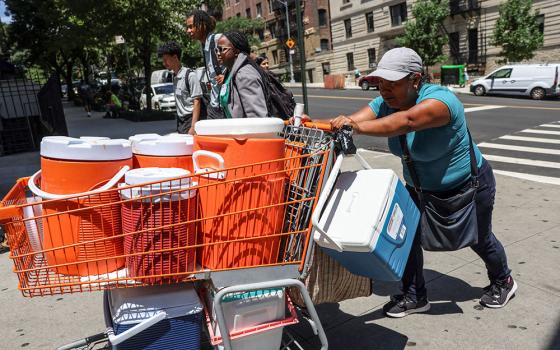Not long ago, the legendary theologian Walter Wink and his wife June invited me to lunch with friends in Santa Fe. It was a blessing to enjoy their company, but I'm still nervous around my old friend Walter. I consider him one of Christian history's greatest scripture scholars because of his ground-breaking analysis of the Sermon on the Mount, especially Matthew 5:38-42, in his book Engaging the Powers, (Fortress Press, 1992). It's a book that anyone interested in Gospel nonviolence should read. He explained as never before Jesus' teachings on nonviolent resistance: "You have heard, 'An eye for an eye and a tooth for a tooth,' but I say, Offer no violent resistance to one who does evil."
The Torah tried to regulate fair punishment so that punishment would not exceed the injury, but here Jesus prohibits any form of punishment or violent retaliation. He advocates a brand new way of life: nonviolent resistance to oppression and imperial domination.
Walter Wink unpacks the Greek word, antistenai, which means "to resist violently, to revolt or rebel with violence." Jesus says, "Offer no antistenai, no violent resistance to one who does evil." In other words, do not use violence to resist evil. Do not continue the downward spiral of violence. Jesus wants us to break the downward cycle of violence by refusing to cooperate with violence, refusing to retaliate with further violence. Violence in response to violence can only lead to further violence, he teaches. "Do not mirror evil," Wink translates Jesus. "Do not repay evil for evil." Gandhi put it this way: "An eye for an eye only makes the whole world blind."
But does that mean sit back, be passive, and suffer violence? No! The world tells us there are only two options in the face of violence: fight back with violence or run away and do nothing. But Wink explains how Jesus offers a third alternative, "a third way": active nonviolence resistance. Jesus doesn't advocate passive resignation or indifference to evil. Quite the contrary. He teaches and practices active, steadfast resistance to every form of violence and injustice. He just does not use the same means as the oppressor.
The fifth antithesis in the Sermon on the Mount is one of the key teachings of nonviolent resistance to evil in history. It's long been interpreted as passivity, but instead it calls for creative nonviolent action. Jesus wants us to resist evil with active nonviolence, stand our ground, speak the truth, insist on our common humanity, disarm our opponent, risk suffering love, trust in God, and work for the conversion of our opponent, so that the one who does evil or supports systemic injustice, changes. The goal is to lead the opponent to a change of heart, to melt his heart, win him over to the truth, stop the violence, and help others discover God's reign of love and peace. Like every good teacher, Jesus does not leave us just with the theory. He gives five concrete examples about how to do this.
First, "when someone strikes you on your right cheek, turn the other one to him as well." As Wink says, a right-handed blow in a right-handed world would land on the left cheek! (To strike the right cheek with a fist would require the left hand, but the left hand was only used for unclean work; you could be punished for using your left hand.) So the only way to strike someone's right cheek with your right hand would have been with the back of the hand, which means Jesus is describing an insult not a fistfight. He's talking about the violent humiliation of a slaveowner or Roman soldier toward the oppressed people of Galilee, an unequal relationship in which violent retaliation would invite retribution. Turning the other cheek in the face of such humiliation would stop the oppressor and assert one's dignity, equality and humanity. It would put the oppressed on equal footing and as Wink explains, say, "I deny you the power to humiliate me. I am a human being just like you." As Gandhi said, "The first principle of nonviolent action is non-cooperation with humiliation."
Wink's insight changes everything. Jesus does not want us to passively suffer the violence of our oppressors. He wants us to nonviolently resist their injustice. He wants the oppressed to risk nonviolent action for their liberation. He tells us we are not helpless, not powerless, not despondent. He wants us to do something.
"If anyone wants to go to law with you over your tunic," Jesus says next, "hand him your cloak as well." In Jesus' time, as in ours, the poor were forever in debt. People wore outer and inner garments, but as Wink writes, they were hauled into court and sued even for the clothes off their back. Only the poorest, those Jesus addressed, would have nothing but an outer garment to give as a loan. So when they demand your outer garment, he says, give them your inner garment as well.
But if a poor person was sued in court for his outer garment, and gave away his inner garment too, he would find himself naked before the court, which was not only taboo in Judaism, but criminal. But not for the poor person! In those days, it was illegal to look upon a naked person. Jesus' audience would immediately realize that the judge and the soldiers would have to arrest themselves for violating the law, and the poor person would go home free. Jesus teaches the oppressed not to be awed by power, but to respond creatively, disarm their opponents and nonviolently liberate themselves. Jesus offers, in Wink's words, "a practical, strategic measure for empowering the oppressed."
"Should anyone press you into service for one mile," Jesus says again, "go with him two miles." Roman soldiers forced the poor to carry their heavy packs for them. By law, however, the soldiers were not permitted to force the poor to walk more than one mile with their packs. These Galileans were totally oppressed and terrorized by these Roman occupiers (much like the Iraqi people today). Jesus shows them a way to nonviolently resist the soldiers. Go an extra mile, he says. His audience would understand that any soldier would be arrested for breaking the law and imprisoned. If everyone in Galilee did this, all Roman soldiers would be imprisoned. Jesus doesn't say: kill the Roman soldiers or fight them. He does not advocate sitting back and passively suffering their oppression. He teaches creative nonviolent resistance to transform the situation without violence. You are not helpless, he insists. Use creative nonviolent action to end oppression.
"Give to the one who asks of you," he says next. Instead of making money and hoarding it, he overturns capitalism and teaches us to give to those in need, and as Luke's later explains, without asking for anything in return. Be generous, selfless givers. "Jesus counsels his hearers," Wink writes, "not just to give alms and lend money, even to bad risks, but to lend without expecting interest or even the return of the principal."
Finally, Jesus says, "Do not turn your back on one who wants to borrow." Lend to others; don't turn your back. Be generous. If we applied these Gospel economics socially and globally, we would end our hording, return the resources we have stolen from the poor, feed the hungry, house the homeless, heal the sick, and never turn our backs on anyone ever again. From now on, we would look one another in the eye, treat everyone with respect and dignity, and reclaim our common, shared humanity.
These five examples show us how to use steadfast nonviolent resistance in the face of violence and imperial oppression. They are the prerequisites of his next teaching, the command to love our enemies. But besides teaching such an exciting alternative to violence, Jesus showed us how to do it in his own life. I think he practiced creative nonviolent resistance every hour of his public life, and engaged in hundreds of disarming nonviolent actions. He was never passive, and he never used violence or retaliated with violence. Even before Pilate, he engaged in nonviolent action. After they killed him, he continued his creative resistance. The resurrection is the ultimate example of nonviolent resistance to the empire of violence and death.
Wink concludes:
Just on the grounds of sheer originality, the examples of unarmed direct action in Matt. 5:39-41 would appear to have originated with Jesus. No one, not only in the first century but in all of human history, ever advocated defiance of oppressors by turning the cheek, stripping oneself naked in court, or jeopardizing a soldier by carrying his pack a second mile. For three centuries, the early church observed Jesus' command to nonviolence. But nowhere in the early church, to say nothing of the early fathers, do we find statements similar to these in their humor and originality. These sayings are, in fact, so radical, so unprecedented, and so threatening, that it has taken all these centuries just to begin to grasp their implications.
Today, millions of people around the globe engage in nonviolent resistance to oppression, war and empire, from Palestine to Iraq, Colombia to Haiti. Here in the United States, we obey Jesus' teachings whenever we nonviolently resist the Bush administration's war on Iraq and all its injustices. Next month, hundreds of us will gather at Los Alamos, the birthplace of the bomb, to creatively resist the culture of nuclear weapons and pursue our liberation from this imperial domination. The key is to put these teachings into practice. That's when they finally come alive and make sense. That's when we become, like Jesus, nonviolent resisters to the culture of violence and war.
John Dear's new book, Transfiguration, (Doubleday) is available from www.amazon.com, and the new DVD about him, "The Narrow Path," is available from www.sandamianofoundation.org. His antiwar trial has been postponed again until September 6th. This week, he will be speaking in London, Oxford, and Edinborough. The annual Los Alamos protest will be held on Aug. 3-4. For information, see: www.johndear.org



